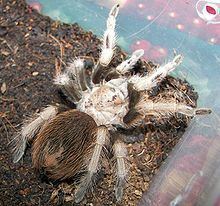Rank Species | Higher classification Aphonopelma | |
 | ||
Similar Aphonopelma, Tarantula, Aphonopelma seemanni, Texas brown tarantula, Aphonopelma anax | ||
Tarantula feeding aphonopelma chalcodes desert blonde tarantula spiders n inverts 20
Aphonopelma chalcodes, commonly known as the western desert tarantula, Arizona blond tarantula or Mexican blond tarantula is a species of spider belonging to the family Theraphosidae. It has a limited distribution in the deserts of Arizona and adjacent parts of Mexico but can be very common within this range. The common name "blond tarantula" refers to the carapace, which is densely covered in pale hairs and contrasts strongly with the all-dark legs and abdomen. The female body length is up to 56 mm, males only reaching 44 mm.
Contents
- Tarantula feeding aphonopelma chalcodes desert blonde tarantula spiders n inverts 20
- Handling big desert blonde tarantula aphonopelma chalcodes inferion7
- Description
- Distribution and habitat
- Ecology
- Life history
- References

Handling big desert blonde tarantula aphonopelma chalcodes inferion7
Description
This 3 to 5 in (8 to 13 cm) large bodied, burrowing spider is commonly seen during the summer rainy season in southwestern deserts. The female is usually a uniform tan color. The male has black legs, a copper-colored cephalothorax and a reddish abdomen. Their burrows can be as large as 1 to 2 in (25 to 51 mm) in diameter, with some strands of silk across the opening.
Distribution and habitat

The Arizona blond tarantula is typically found in saguaro-dominated plant communities. There are many similar species throughout the desert southwest, but they are difficult to differentiate.
Ecology
Tarantulas are nocturnal predators that never venture far from their burrows unless it is mating season. In winter they plug their burrows with soil, rocks, and silk and survive in a relatively inactive state. During this time the animals live off stored fat reserves.

Some Tarantulas have an interesting defensive capability in addition to venom. Some of the hairs on the top of the abdomen are specialized for defense. These urticating hairs, as they are called, are tipped with backward pointing barbs. If a tarantula is threatened in any way, it brushes these hairs into the face, paw or other body part of its attacker. Once these hairs are embedded, they are irritating and very difficult to remove because of the barbs.
Life history

Male tarantulas mature when they are 10 to 12 years of age, at which time they leave their burrows in search of females. Upon finding the burrow of a mature female—she’s usually at least 10 years old—the male will announce himself by stroking the silk at the top of the burrow and tapping particular sequences that the female responds to. During mating, the male must reach under the female to insert his pedipalp into her gonopore to deposit sperm. He is particularly vulnerable to predation by the female when mating. The male’s first pair of legs has a “spur” located behind the knee which he uses to hold the female above him during copulation. After copulation the male makes a hasty retreat. The female lays her eggs in a burrow, sometimes staying with them. The young remain in the burrow until they disperse.
Each time a female tarantula molts, typically once a year, she also molts the lining of her epigynum (the female reproductive structure) where the sperm are stored, so she must mate again before she can produce fertile eggs. The many tarantulas seen on the roads in Arizona during the summer rains (July, August, September) are usually males searching for mates. The male does not survive long after mating. Even in captivity, they only survive a few months after mating.
